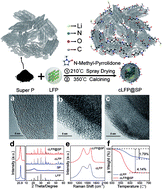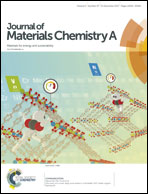Achieving high specific capacity of lithium-ion battery cathodes by modification with “N–O˙” radicals and oxygen-containing functional groups†
Abstract
Enhancing the cathode capacity of lithium ion batteries (LIBs) has been one strategy to improve the energy density of batteries for electric vehicle applications, because of the limitation of inorganic cathode capacity. Here, we developed a new strategy to construct high capacity cathodes by using NMP pyrolysis to grow oxygen-containing functional groups on the Super P carbon black (SP) surface coated on commercial LiFePO4 (cLFP). Structural characterization using electron spin resonance (ESR) and X-ray photoelectron spectroscopy (XPS) showed that “N–O˙” and “C![[double bond, length as m-dash]](https://www.rsc.org/images/entities/char_e001.gif) O” groups were present on the SP surface of cLFP@SP. The redox reaction occurred on these oxygen-containing functional groups and provided the excess capacity, allowing the composite cLFP@SP to achieve a capacity of 190 mA h g−1, which is higher than the theoretical maximum capacity of 170 mA h g−1. This work provides a new approach for enhancing cathode capacity by incorporating suitable “N–O˙” radicals and oxygen-containing functional groups on the surface of cathodes.
O” groups were present on the SP surface of cLFP@SP. The redox reaction occurred on these oxygen-containing functional groups and provided the excess capacity, allowing the composite cLFP@SP to achieve a capacity of 190 mA h g−1, which is higher than the theoretical maximum capacity of 170 mA h g−1. This work provides a new approach for enhancing cathode capacity by incorporating suitable “N–O˙” radicals and oxygen-containing functional groups on the surface of cathodes.



 Please wait while we load your content...
Please wait while we load your content...